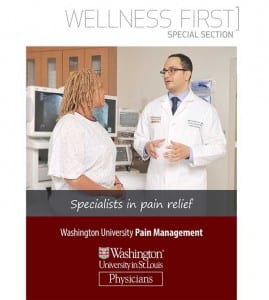As anyone who’s experienced even minor pain knows, it can be distracting at best and debilitating at worst. Those suffering from chronic or severe pain in the back, knees, hips or neck may find relief with Cooled Radiofrequency Ablation, a nonsurgical, minimally invasive procedure offered at Washington University Pain Management Centers.
 Performed in just 15 to 20 minutes, the ablation requires no hospital stay, and the relief it provides lasts six to 12 months, explains Dr. Lesley Rao, a board-certified pain management specialist and anesthesiologist. It works by targeting nerves known to be responsible for transmitting pain. “We insert an electrode into the pain area and use radiofrequency to heat and destroy a small area of nerve tissue so the brain will no longer be able to transmit that pain,” she notes. Afterward, patients are released; besides taking it easy the day of the ablation, there is no required downtime.
Performed in just 15 to 20 minutes, the ablation requires no hospital stay, and the relief it provides lasts six to 12 months, explains Dr. Lesley Rao, a board-certified pain management specialist and anesthesiologist. It works by targeting nerves known to be responsible for transmitting pain. “We insert an electrode into the pain area and use radiofrequency to heat and destroy a small area of nerve tissue so the brain will no longer be able to transmit that pain,” she notes. Afterward, patients are released; besides taking it easy the day of the ablation, there is no required downtime.
To ensure the procedure will be effective, patients are given a local anesthetic at some point beforehand. “The goal is for patients to experience 50 percent pain relief from the anesthetic,” Rao says. In tracking how well the anesthetic works, patients keep a pain diary for eight hours following the injection. “If a patient ranked their pain an 8 out of 10 beforehand, and then said it was 4 out of 10 or less afterward, we would go ahead and schedule the procedure,” Rao adds.
Cooled Radiofrequency Ablation often is presented to patients as an avenue for relief only after other more conservative pain management techniques—such as physical therapy, medications and steroid injections—have been explored, Rao says. “Another option is surgery, but some patients are not good candidates,” she explains. “For example, someone suffering from knee pain might need to lose weight to become a surgery candidate, but the pain might be keeping them from exercising. Without the ablation, these patients would continually be stuck in the middle ground.”
Although ablation results don’t last forever, Rao says many patients don’t end up coming back for a second round. “We use interventional techniques along with the ablation to improve function,” she says. “Many patients’ pain decreases enough with the ablation that they are able to more effectively do physical therapy or lose weight—the procedure is often used to help these other pain management techniques along the way. This is just one more option for people who are really struggling despite all the other options we have.”
Whatever combination of therapy and procedures helps a patient find relief, Washington University Pain Management offers a very broad spectrum of options by integrating clinical practice, research and education in the mission to alleviate suffering. “We’re at the forefront of clinical science,” Rao says. “Clinical studies, even within our group, are being conducted to validate the procedure and make sure we have the scientific data to support the positive patient reports we’ve been receiving.”
Washington University Pain Management has locations on the Barnes-Jewish West County Hospital campus, Missouri Baptist Medical Center and the Washington University Medical Center campus. Each location offers minimally invasive, nonsurgical Cooled Radiofrequency Ablation for chronic SI joint, knee and hip pain. Pictured on the cover: board-certified pain specialist Dr. Michael Bottros attends to a patient. For more information, call 314.996.8631 or visit pain.wustl.edu.
Pictured: Pain management specialist Dr. Lesley Rao
Photos and cover design courtesy of Washington University Physicians








